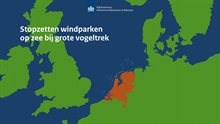Shutting down offshore wind turbines during peak bird migration
On nights when migratory birds fly en masse through offshore wind energy areas, wind farm owners must shut down the wind turbines. With this so-called start/stop procedure we want to ensure that fewer migratory birds fly into the turbines.

[Shutting down offshore wind turbines during peak bird migration]
On some nights in spring and autumn, millions of migratory birds fly across the North Sea. To ensure that as few birds as possible collide with the rotating blades of wind turbines, the government takes measures. One such measure ensures that, during anticipated peak bird migration, offshore wind park owners shut down their turbines.
During this process, various parties take action, following a step-by-step plan. This is the start/stop procedure.
The first step is to predict the bird migration. To this end, a bird migration prediction model was developed, which is used during migratory periods. This model forecasts the expected bird migration for upcoming nights on a daily basis.
A forecasted significant bird migration triggers a bird alert and a notification to the on-call service responsible for overseeing the start/stop procedure.
TenneT, the operator of the national electricity grid, is also immediately informed. TenneT assesses the impact on the security of supply of offshore wind turbines temporarily powering down operation. Subsequently, TenneT advises the Ministry of Economic Affairs and Climate Policy on whether it's safe to shut down the offshore wind turbines.
At the same time, a team of migratory bird experts receives the bird alert notification. This bird expert team also advises on the expected bird migration.
Each party makes the necessary preparations during the time between the bird alert and the ministry's decision.
Based on the advices received, the Ministry of Economic Affairs and Climate Policy decides whether to shut down the offshore wind turbines.
If the ministry decides to shut down the wind turbines during a specific night, it promptly announces this decision. The announcement includes the date and the exact start and end times of the measure. Usually, the shutdown lasts a few hours.
Immediately following this decision, wind park owners publish a notice stating the times of the offshore wind turbines shutdown due to significant bird migration.
At the specified time, wind park owners shut down the turbines. This means reducing the rotation speed of the turbines to less than two rotations per minute. Complete shutdown is not preferred for technical reasons and for the birds, this near shutdown suffices.
The Inspection and Law Enforcement Unit of Rijkswaterstaat conducts an inspection to ensure that wind park owners have correctly executed the start/stop procedure.
Rijkswaterstaat, together with the involved parties, evaluates the procedure and assesses the actual size of bird migration. The evaluation helps to enhance the bird migration prediction model. This way, we continually improve our ability to provide migratory birds with a free and safe passage across the North Sea, while optimising the use of offshore wind energy.
[For more information, visit www.rijkswaterstaat.nl / www.noordzeeloket.nl
Rijkswaterstaat, Ministry of Infrastructure and Water Management.
A production of Rijkswaterstaat, copyright 2024.